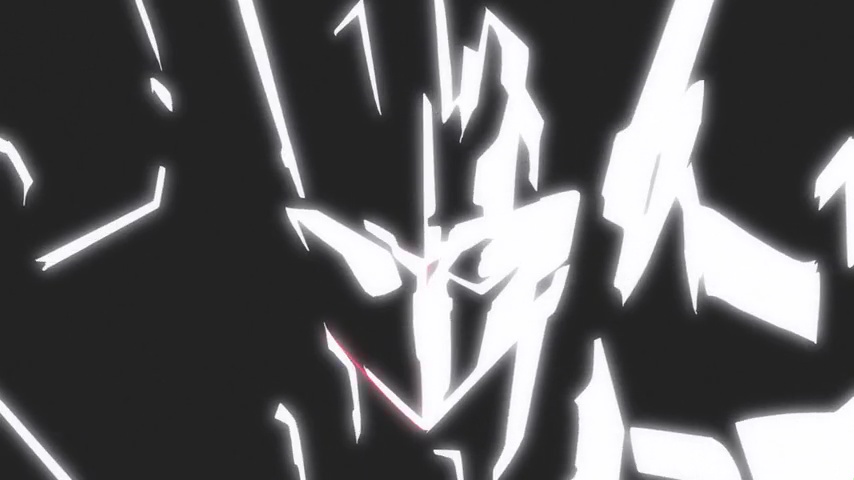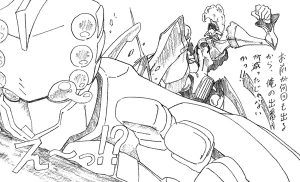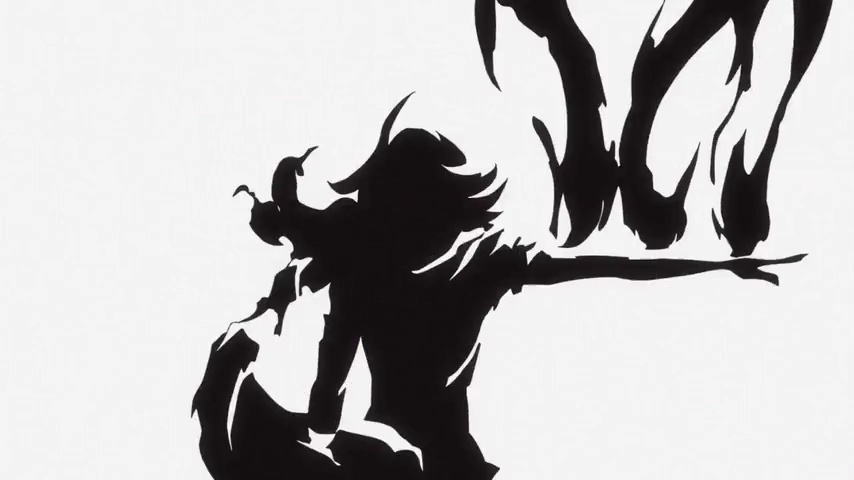
Anime’s Future: Kenta Yokoya
That hand drawn mechanical animation is in a tricky spot is no secret. As much as many of us personally love it, there’s no denying that it’s exhausting work that’s inherently more suited to 3D craft. Add to that the general issues the industry suffers from, and over the years you get less and less newcomers willing to specialize in this subject. That’s why we’ll be dedicating this new entry in our series about the anime creators who will shape anime’s future to one of the big hopes for 2D robots – Kenta Yokoya, a mechanical and effects animator raised in an environment with some of the finest veterans in the field with the goal to keep the dream alive.

- Name: Kenta Yokoya (横屋健太)
- Roles: Key animator, animation director, mechanical animation director
Although I already had it in mind to write about his work, it’s not by coincidence that I’ll be talking about Yokoya today. His appearance within three currently airing anime over the last couple weeks make it feel very timely, and it’s worth noting that they’re interesting contributions too. Sunghoo Park’s GARO Vanishing Line keeps on attracting various mecha animators, so his appearance on #7 and particularly the sakugaSakuga (作画): Technically drawing pictures but more specifically animation. Western fans have long since appropriated the word to refer to instances of particularly good animation, in the same way that a subset of Japanese fans do. Pretty integral to our sites' brand. spectacle #8 was nice yet not all that surprising. On the other hand, no one would have expected him to show up on Dragon Ball Super‘s 116th episode in such a fancy way. It was veteran animator Ken Otsuka, the current backbone of 2D mecha in anime, who brought Yokoya along to give him breathing room while he was struggling with another job. That third appearance happened to be in Blood Blockade Battlefront & Beyond‘s seventh episode, where Yokoya got to supervise character animation for the first time. These hectic weeks prove that he’s already in high demand and that he’s formed important connections in the industry. Let’s now take a look at his career to see how he earned that acknowledgement.
In contrast to some of the very fresh talent we’ve chosen to highlight in this series, Kenta Yokoya has been around for exactly one decade at this point – not all promising figures in the industry are extremely young after all! He entered the industry in 2007 as a fresh employee of BONES’ Animation Department, which exclusively hires rookie in-between animators to nurture them into key animators. Their graduation is meant to signify that they’re skilled enough to make a living on their own as freelancers, so they all leave at that point. His first works as an in-betweener included episodes 3-5 of the Ayakashi Ayashi (2007) OVA series and BONES-produced episode 7 of Bamboo Blade. His debut on BONES’ own TV anime was on Soul Eater (2008), but as it tends to happen with in-betweeners, his name was often omitted from the credits as the studio itself gets listed instead. Because of that he was only explicitly credited three times, despite contributing much more regularly to it. He then provided in-betweensIn-betweens (動画, douga): Essentially filling the gaps left by the key animators and completing the animation. The genga is traced and fully cleaned up if it hadn't been, then the missing frames are drawn following the notes for timing and spacing. for Fullmetal Alchemist: Brotherhood (2009-2010) and slowly moved up the ladder within the studio, as he began to show outstanding potential to draw mechanical objects and effects. That paid off with Star Driver (2010), where he was paired with the same-year colleague Iori Nonoshita (currently working as animation director at A-1 Pictures) and got tasked with supervising the quality of the in-betweensIn-betweens (動画, douga): Essentially filling the gaps left by the key animators and completing the animation. The genga is traced and fully cleaned up if it hadn't been, then the missing frames are drawn following the notes for timing and spacing. for multiple episodes. Later, both of them debuted as key animators on the same show. Star Driver seems to be the show that truly marked a turning point for him: not only with his promotion to fully fledged key animator, but also as the beginning of his love story with mecha anime.

He graduated from BONES’ Animation Department in 2011, though as a freelancer he kept a good work relationship with them; not only does the studio make an effort to keep track of the promising artists they’ve seen grow, the animators themselves also gladly return to the place where they learned so much. At the same time he also gained new contacts across the industry – most notably at Sunrise Studio 3, known for producing the main hand-drawn iterations of Gundam nowadays, and studio SHAFT. Not by coincidence, these all happen to be located in Tokyo’s Kamiigusa area, within the near vicinity of BONES – he left his parents’ home, but didn’t move all that far! Thanks to these new connections he became involved with iterations of Gundam franchise like AGE (2011-2012) and Build Fighters TRY (2013-2014), while also contributing to titles like the Monogatari franchise and Nisekoi. It still was with BONES that he performed at his best however, so after proving his animation prowess on the unfortunate Eureka Seven AO (2012), he was hired to work on the new original anime by Star Driver‘s team: Captain Earth (2014), where he got an opportunity to debut as a mecha animation director on its 22nd episode.
That fully established him as one of BONES’ – and the industry’s as a whole – new mechanical animation assets. There aren’t that many animators who can be trusted with ensuring the quality of mechanical cuts anymore, so this promotion holds much more weight than raising one’s status to standard supervisor. This new status allowed him to participate in Concrete Revolutio (2015-2016) as a regular mecha animation director and key animator from the very beginning, which also made animation fans become aware of his talent. His reliability and the sheer quality of his work then got him hired as one of main animators for Eureka Seven: Hi-Evolution 1‘s exhilarating Summer of Love sequence, giving him a chance to work closely with mecha and effects animation legends like Yasushi Muraki, Shuichi Kaneko, and Hideki Kakita. Just in a few years, he had made the full journey from a talented newcomer to a pillar of this field, hanging out with his heroes who had been sustaining it.
To some degree it feels unfair to only talk about his progression as a mechanical animator, since his work is far from limited to that. As I mentioned earlier he’s also kept a steady relationship with studio SHAFT which obviously doesn’t involve many robots, and even on studio BONES’ shows like Concrete Revolutio his output wasn’t limited to mechs. However, the truth remains that mechanical and effects animation are his major strength and that’s the reason why his name has spread across the industry so fast. But achievements aside, what is his work like? Career trivia can be interesting and tends to explain by whom someone’s style was shaped, but at the end of the day we’re here to look at the work these artists put out. One of the first animation sequences tied to his name we knew of, and a very telling one when it comes to his style, was this excellent missile launch from Captain Earth‘s first episode. Despite being really short it visibly displays one of Yokoya’s quirks: the dispersion of smoke effects, halfway through a net and loose threads. If you compare it to the escape scene he animated for Concrete Revolutio‘s 14th episode, you can see how similar the shapes and the way they’re placed are, despite the nature of the scene being so different.

The latter scene also showcases that he’s really good at animating perspective shots, a fundamental skill when it comes to mechanical animation; robots tend to be bulky and solid bodies, their shows emphasize the space they occupy, and to nail that while in motion you need excellent sense for perspective. In episode 18 he once again showcased that sense during the scene where Jiro runs up Daitetsu’s robot and rescues Earth-chan from its grasp. If you look past the mechanical part, that scene also offers an interesting glimpse onto another side of him: the very liquid fire effects, which he’s also displayed in other instances like the final episode showdown between Jiro and Satomi, which is one of his rare confirmed pieces of work without any mechanical objects present.

I’d also like to highlight Yokoya’s presumed contribution to ConRevo‘s 22nd episode in the form of this gattai sequence, where he creatively implemented animated impact framesImpact Frames: Usually monochromatic or otherwise chromatically stylized drawings hidden within sequences to give them extra oomph. While they tend to flash for a fraction of a second for the most part, some animators choose to flaunt them instead. into the scene. Not only does it create an interesting effect, it feels particularly fitting with the show’s colorful palette. I get the feeling he might have been directly influenced by Yasushi Muraki, who often worked alongside him and even supervised Yokoya’s animation in the past. After all, Muraki animated a similar scene for the first episode!
You might have noticed that this feels a bit dry compared to the usual commentary on interesting anime creators. The reason is simple: a few notorious exceptions aside, mechanical animation isn’t exactly the best field when it comes to personal expression. Shows with pseudo-realistic approach – if you can even call it that – to the depiction of robots like Captain Earth don’t leave much room to the animators to show off their idiosyncrasies. Mechs are meant to stay on-model more rigorously even than characters themselves, hence why it’s the style of mecha designers that gets discussed a lot instead. When they’re simply animators and supervisors, arguments about personal styles revolve around more subtle details like the timing of the animation… or in cases like this, about an inseparable extra: the effects. 2DFX has been married to robots since the inception of anime, and amusingly enough that tends to be the most explicit tell of many mecha animation experts. As talented as they might be drawing robots, it’s often the idiomatic effects attached to them that makes individual artists easy to tell apart! That is without a doubt the case with Yokoya as well, as it was with other exceptional animators like Sejoon Kim. Much like him, Yokoya is now also trying to broaden his horizons and improve his character animation skills. And that takes me back to his standard animation directionAnimation Direction (作画監督, sakuga kantoku): The artists supervising the quality and consistency of the animation itself. They might correct cuts that deviate from the designs too much if they see it fit, but their job is mostly to ensure the motion is up to par while not looking too rough. Plenty of specialized Animation Direction roles exist – mecha, effects, creatures, all focused in one particular recurring element. debut on Blood Blockade Battlefront & Beyond‘s seventh episode, which I’ll cover in my next post. Stay tuned!
Support us on Patreon to help us reach our new goal to sustain the animation archive at Sakugabooru, SakugaSakuga (作画): Technically drawing pictures but more specifically animation. Western fans have long since appropriated the word to refer to instances of particularly good animation, in the same way that a subset of Japanese fans do. Pretty integral to our sites' brand. Video on Youtube, as well as this SakugaSakuga (作画): Technically drawing pictures but more specifically animation. Western fans have long since appropriated the word to refer to instances of particularly good animation, in the same way that a subset of Japanese fans do. Pretty integral to our sites' brand. Blog. Thanks to everyone who’s helped out so far!
I was wondering the reason for mecha anime decline aside from “muh isekai” and given the demanding nature of animating a mech, it’s definitely too time consuming for the current TV climate. Still it’s a pretty cool story of a guy starting from inbetweener to an amazing key animator and AD.
Are there other studios that have programs to teach budding animators like Bones and KyoAni?
This one is tricky. Do other studios have systems to train animators? Yeah, the vast majority of them do. Are they effective? Not at all, that’s why initiatives like Anime Mirai were deemed necessary. You have to leave KyoAni aside here – they’ve had a regular training course for a very long time, the management capability to properly train youngsters within the studio, and a company motto that’s all about raising talent to begin with. But the thing is, approaches like the BONES one detailed here are fairly common. All studios are interested in not only teaching young artists, but… Read more »
This is inspiring I’m going to try and draw some Mecha animation.